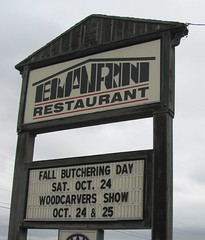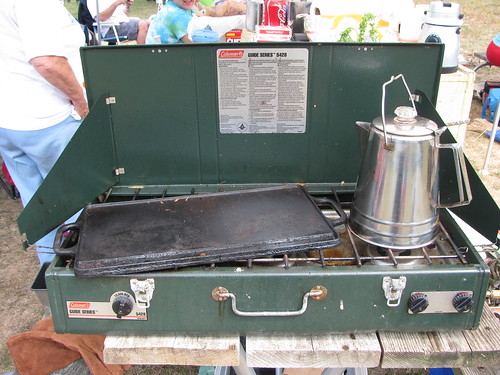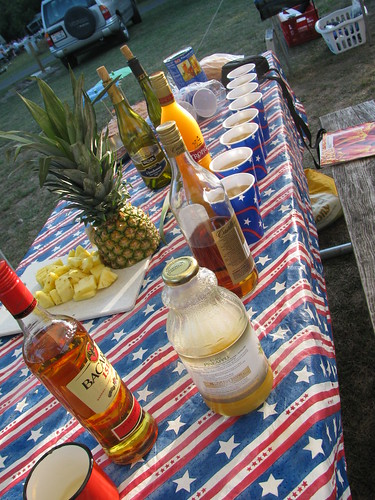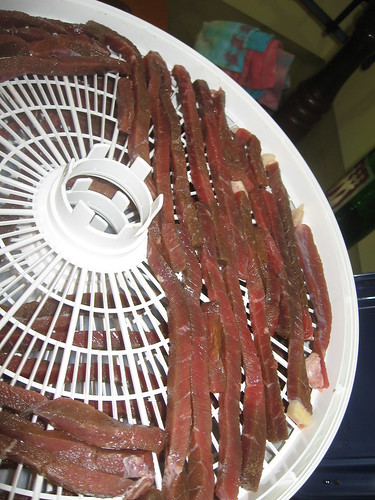 When I first heard about the Ohio Fish and Shrimp Festival a few years ago (it has been running for 8 years), I thought it was too weird to be true. This year our schedule aligned with my father's band, Bunty Station, being booked at the show and we had to go see for ourselves.
When I first heard about the Ohio Fish and Shrimp Festival a few years ago (it has been running for 8 years), I thought it was too weird to be true. This year our schedule aligned with my father's band, Bunty Station, being booked at the show and we had to go see for ourselves.
The festival is held at Freshwater Farms of Ohio in Urbana. After an out-of-cellphone-service induced series of misdirections, we made it to the small farm. The first person we saw was an elderly man who handed us a brochure and told us excitedly about the sturgeon petting in the fish barn. Sturgeon petting?!?
The next thing we walked by was this menu:

What to do? Touch a fish I never knew I wanted to pet or eat Michael's local potatos?
Lil made the decision for us as she ran towards the fish barn.
Entering the small door to the very large one story metal barn, we were first drawn to the tanks upon tanks of Ohio freshwater species. The blue gill, catfish, snapping turtles, crayfish, and more were in neatly labeled tanks for demonstration and research. The farm welcomes individuals to tour the farm and shop their farm market Monday - Saturday.

After touching a painted turtle and frog, we finally came to the sturgeon tank. Lil dove in and pet one of the five foot, seventeen year old fish right between the eyes. Not a fan of slippery things, but still curious, I touched one as well. It was slimy and hard. I mentioned that the sturgeon's strange face reminded me of the Dunkleosteus head at the Ohio State University's Orton Hall Museum.

Talking to the well informed fishery keeper and some Wikipedia research revealed that I wasn't far off. (I do hold a degree in Geology.) Sturgeon first appear in the fossil record about 200 million years ago and still very much resemble their ancestors. Unlike most modern fish, the sturgeon has bony plates as a skull and a host of other unusual characteristics. The can live up to a hundred years and grow to enormous size.
First spawning between 20 - 25 years of age, sturgeon population increases slowly. Due to humans' huge appetite for caviar (sturgeon roe, harvested by killing the mother fish), the sturgeon population is endangered throughout the world. Fresh Water Farms keeps their sturgeon specimins alive to see if they might be able to induce captive spawning to help repopulate Ohio.
The rest of the farm's large tanks are populated with catfish, trout and pond fry. Fish can be purchased as stock for your own pond. They sell a variety of retail fillets and smoked fish products available for pickup in Urbana. Freshwater Farms supplies a large portion of Ohio restaurants with Ohio trout as well.

After all the fishy excitement, I was hungry and convinced the family to walk back towards the food. In addition to the big menu served by Freshwater, there were several other food vendors. We came for the Ohio foods and happened to be gifted my father's comp meal ticket, so we stuck with Freshwater.
The food line was long because everything was hand cut or battered and fried just before service. By the time our fried catfish, hand cut chips, au gratin potatos, cole slaw, green beans, and hot dog arrived, I was so hungry I forgot to take pictures! Bad food blogger!
Everything was tasty and obviously home made. The chips were the clear winners of the night. Alex watched them double fry each batch and you could tell: perfectly cooked, crispy, and salted.
Lil and I explored some of the ample kids activities while waiting for Dad's band to play. They had a large sand pit, balls, and a ball catapult for kids to play with. Earlier in the day were some organized activities. Finally Bunty Station went on and we enjoyed the show.

I have to admit that my expectations for the Fish and Shrimp Festival were low. I was prepared for smelly fish barns, troublesome waste, and/or that corporate farm feel.
Happily we found only a wholesome business. I can recommend Freshwater Farm's as a local, sustainable fish source. The festival, an easy hour's drive from Columbus, was great free entertainment on a perfect early fall evening. Even if Bunty Station is not invited back, we will return to pet the sturgeon again!
 When served meat, Lil often asks "What part of the aminal is this?"
When served meat, Lil often asks "What part of the aminal is this?"


 When I first heard about the
When I first heard about the 




















